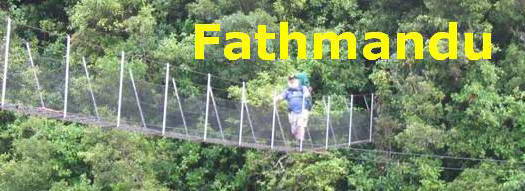
Many thanks for permission to use graphics from their software and toposheets |
 |
|
26 June and 3 July 2008 Lake Kereta, South Headpage 1 Some years ago we went up to Wilson Rd, off the South Head road, to visit Mark and Lesleigh, and we were taken on their John Deere for a ride out to the coast and along the beach. The route started at a gate by the southern end of Lake Kereta and headed along Deacon Rd to the coast. In the years following, access through the forest to the coast for the public became a matter of prolonged dispute, and was eventually resolved in favour of the public. However, the route agreed on no longer followed Deacon Rd, but instead, a 4WD access was bulldozed along the western edge of Lake Kereta for about two thirds of its length, before heading more or less straight out to the coast. Access to Inland Rd is barred by locked gates and large blocks of concrete, and access to Coast Rd has been blocked by a combination of tank traps and bulldozed tree trunks, which also feature along much of the route so as to prevent any vehicle access to the pine forest. Last month, Lesleigh returned from Napier for a visit, and we went out to Wilson Rd, and about a week later I took Miranda out there and right out to the coast. This is the route we followed.
At this time of the year, vehicle use was minimal. As the sandy surfaced road is winding and narrow - wide enough for one 4WD only for most of the route - and bears evidence of fast travelling vehicles it may not be a completely safe option for pedestrians in the summer months. Or for 4WD vehicles either if it comes to that.
Lake Kereta, so the signs tell us, is on the verge of ecological collapse.
Around the edge, for many years now, there has grown a thick fringe of Manchurian Rice Grass, several metres tall, dominant in much the same way as kikuyu is dominant, and highly resistant to eradication. About ten years back I was given a young orchard tree from Mark's farm nearby that was surplus to requirements, and one piece of the rice grass accompanied it. For ten years I pulled this grass up wherever I saw it sprouting around the tree, and for ten years it regrew from small fragments. Even Roundup seemed ineffective. Eventually I painted it with undiluted Roundup, which seemed to do the trick. My first thought was, "How on earth are you going to get rid of that grass without the ecology being totally destoyed in the process, anyway, like the famous village in Vietnam that the American armed forces were forced to destroy in order to rescue it?"
However, it does seem to be diminishing, and I wish them well. In the picture above, you can see the pale brown leaves just below, and some on the opposite shore. Raupo would be far more preferable, but that's in the future. At this point we are walking along the lake edge though a belt of tallish kanuka, and a bunch of whatever else is able to survive on almost pure sand. Ink weed,
tobacco weed...
and a heap of Parsonsia (kaihua) in full bloom. This is the vine that thrives in the pine forests to the south around Woodhill, where almost nothing finds a home except pampas grass, kanuka, small leaved Coprosma and a few ferns. But I've only rarely seen it down there in as luxuriant bloom as this.
They call it the Maori jasmine, and it has a mild and pleasant scent, but nothing compared with my expectations of it. I can't say the same for the basket fungus, which is fully as putrid smelling as its reputation suggests. Lots of it about, too.
We carry on beside the lake, heading generally north.
Along the way there's a large sign, which I would think relates to the recent access dispute. Judge Fenton was an early and prominent judge in the Maori Land Court, and this piece of land we are now walking through he used to farm, with his neighbour being the well-known stock and station agent, Alfred Buckland. Haere mai, for New Zealanders, needs no translation. Welcome! "Huariki ki te tahatika" means roughly, "the route to the coast". Interesting. While I had heard of the dispute, I had not been aware there was a Maori element.
A dozen or so black swan glide across the water in the far distance, and Alice pays keen attention. With all that hair hanging across her eyes, and from ground level, almost, her sight is still considerably better than mine. Just below us the lake divides nearly in two. Lake levels here have a cycle of approximately thirty years, the time it takes for the pine forest nearby to mature and be harvested, Mark's young orchard, comfortably clear of the lakes on his farm, turned into swamp at the last harvest, when the water levels rose by two metres inside a few weeks.
The present level will continue to drop gradually for the next twenty years or so, and a floating jetty on the far side is built to accommodate this.
We continue through the kanuka at the lake edge
We're not the first by here today. Deer. We'll see plenty of hoofprints closer to the coast, but no hooves.
We turn sharply left and uphill and quickly leave the kanuka and scrub behind.
On either side of the road are tank traps to prevent or at least impede vehicular access. Elsewhere, felled trees are piled along the edge of the road, or a combination of both.
I'd say the digger driver brought his rubbish bags along with him. Or maybe he was just covering stuff somebody else had dumped. C-L-E-A-N U-P N-Z, I think it says.....
|
|